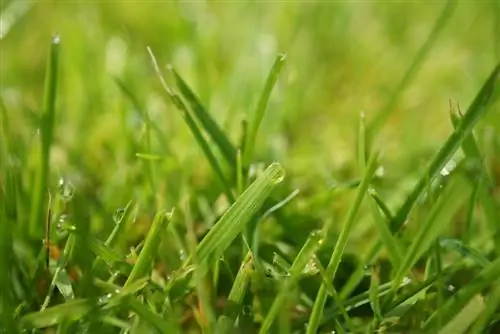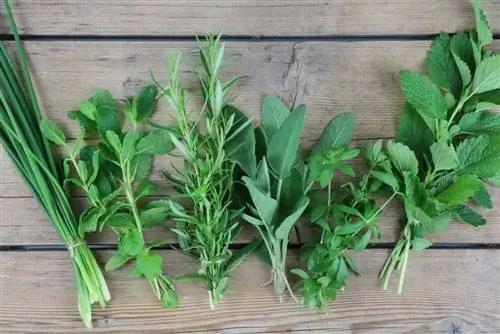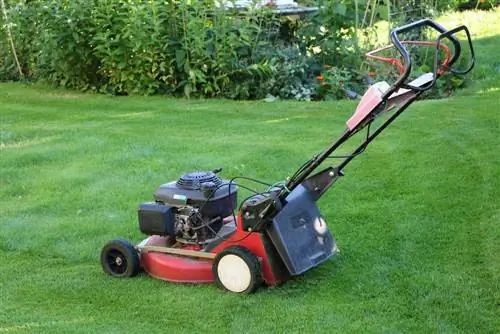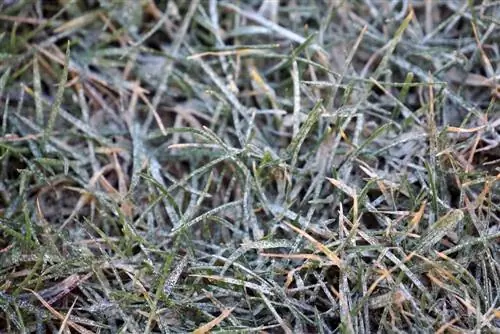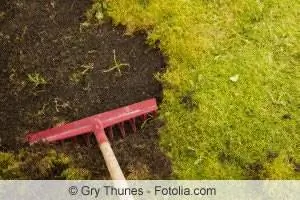- Author admin [email protected].
- Public 2023-12-17 03:39.
- Last modified 2025-01-24 12:45.
So that your lawn can quickly overcome the rigors of winter, sulfuric acid ammonia has proven to be a proven fertilizer. The mineral fertilizer has an effective combination of nitrogen and sulfur. With this starting aid you will strengthen the growth of the noble grasses and annoying weeds will be left behind. Our green guide has made it its mission to provide you with practical information about the competent use of ammonium sulfate fertilizer for the lawn.
Ammonium sulfate compensates for nitrogen deficiency
He althy nutrition is just as important for a lawn as it is for people and animals. For the noble grasses, nitrogen is the main nutrient on the green menu, which is an important driver of growth. Nitrogen contributes significantly to photosynthesis so that the lawn thrives as a dense, lush green carpet. Symptoms of deficiency can be recognized by yellowish stalks, stunted growth and sprouting weeds. The undersupply does not occur because your lawn has used up its nutrient supply. Rather, the soil cannot store the existing nitrogen for long. To make matters worse, large amounts of nitrogen are washed out of the soil.
In the form of ammonium sulfate fertilizer with 21 percent nitrogen and 24 percent sulfur, fresh supplies of nutrients reach the grass and compensate for the deficiency. Specifically, this is an easily degradable s alt that is approved in the EU as a food additive E 517. The combination with sulfur as a water-soluble sulfate optimizes the ability of the lawn grass to absorb nitrogen. At the same time, the pH value in the soil is reduced to a moderate extent.
Test the pH value in advance
The property of sulphate of ammonia to lower the pH value in the soil is only desirable if the value is at an acceptable or too high level. The ideal pH value for your lawn is between 6 and 7. Excessive fertilization with lime causes the value to skyrocket, which can be seen in the increased growth of clover and the like. If the value falls into the acidic range below 6, moss has the upper hand over the lawn grasses.
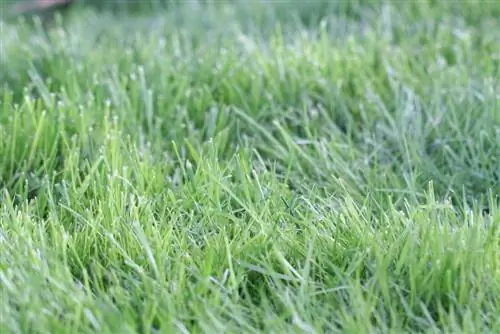
When the window for lawn care opens in spring, a pH value test should be at the top of the to-do list. You can purchase test sets at reasonable prices in garden centers and hardware stores. A score below 6 requires you to first lime your lawn to regulate soil acidity. After waiting 2 to 3 weeks, apply the ammonium sulfate fertilizer. If the pH value test produces a result of 6 to 7 or higher, the administration of lime is removed from the care plan in order to apply sulfuric acid ammonia to the green area without this intermediate step.
Tip:
Inorganic compounds are frowned upon as nitrogen fertilizers in ecologically oriented gardens. Horn shavings and horn meal contain 12 percent nitrogen and are ideal for supplying lawns with organic nutrients. The only disadvantage is a wait of at least two months until the noble grasses benefit from the nitrogen. The beneficial effect lasts for several months.
Fertilizing with ammonium sulfate
Have you prescribed sulfuric ammonia to your lawn to encourage weed-free, dense growth? You can then apply the fertilizer as a spreading agent or in liquid form with a watering can. Choose an overcast, slightly rainy day so that the grass can absorb the preparation better. How to do it professionally:
As gritting agent
- Filling ammonium sulfate fertilizer into a spreader truck
- Set dosage to 80 grams per square meter
- Walk along the lawn with the spreader in lengthways
- Avoid overlapping tracks
- Wrinkle afterwards in dry weather
As liquid fertilizer
- Dissolve 45 to 50 grams of fertilizer in a 10 liter watering can
- Apply 1 watering can of the fertilizer solution per square meter of lawn area
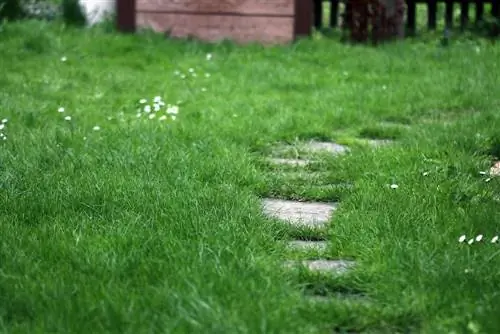
Administer liquid ammonium sulfate fertilizer more economically using the spray bottle. If you choose this alternative, you can reduce the dosage to 35 grams per 10 liters. Many manufacturers recommend administering ammonia sulfuric acid at two-month intervals between April and September. Top-fertilization only proves to be necessary when the condition of the lawn requires further nutrient supply.
Tip:
The willingness to absorb ammonium sulfate fertilizer is significantly increased if you scarify your lawn in advance. A special scarifier thoroughly combs all weeds and moss from the green area.
Not suitable as autumn fertilizer
If you want to strengthen your lawn again before winter, a nitrogen-based fertilizer such as ammonium sulfate is out of place. Increased growth at the end of the season creates thin-walled, water-rich cells in the grasses that are highly susceptible to frosty temperatures and fungal infections such as snow mold. Therefore, administer a potassium-rich lawn fertilizer in autumn, which explicitly strengthens the cell walls and lowers the freezing point in the cell water.

